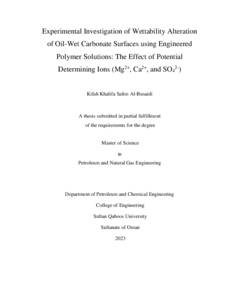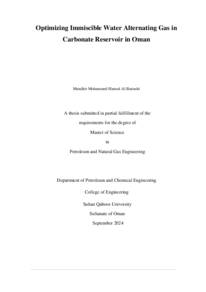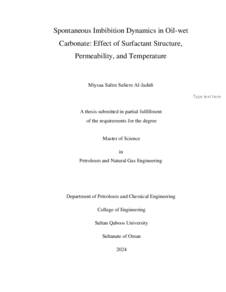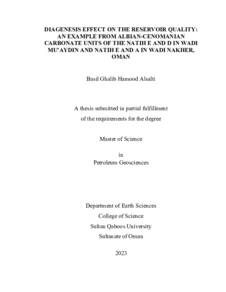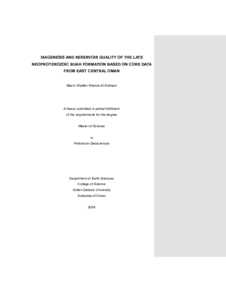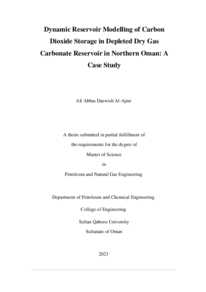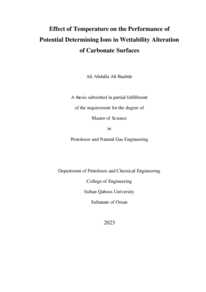وثيقة
Experimental investigation of wettability alteration of oil-wet carbonate surfaces using engineered polymer solutions : the effect of potential determining ions (Mg2+ , Ca2+, and SO4 2-).
عناوين أخرى
دراسة تجريبية لتحليل قابلية تغيير بلل أسطح الصخور الكربونية المحبة لنفط باستخدام محاليل (EWP(: تأثير أيونات الماغنسيوم والكالسيوم والكبريتات (PDIs(
الناشر
Sultan Qaboos University.
ميلادي
2023
اللغة
الأنجليزية
الملخص الإنجليزي
More than 50% of the world's oil reserves are held in carbonate reservoirs. In recent years,
EOR methods developed for sandstone reservoirs can be enhanced for application in
carbonates. One promising method is the use of engineered water polymer flooding
(EWPF) with the synergistic effect of combining engineered water (EW) and polymer
flooding (PF). The combination of EW with PF could result in a modification of the rock's
wettability, reduction of the mobility ratio, promotion of polymer stability, and reduction
of the required polymer concentration. However, limited studies addressed the
simultaneous effect of engineered water compositions (i.e. potential determining ions
(PDIs)) on the viscosity of polymer and wettability alteration of carbonate surfaces at harsh
reservoir conditions of salinity and temperature. Accordingly, this study aimed to
investigate the effect of salinity, PDIs, and polymer functional groups (partially hydrolyzed
polyacrylamide (HPAM), and, acrylamide tertiary butyl sulfonic acid (ATBs)) on the
wetting properties of calcite, chalk, and dolomite surfaces as well as the viscosity of
solutions. The experimental protocol included viscosity, contact angle (CA), pH, and static
adsorption tests. All tests were carried out at 75 °C, a representative temperature of an
Omani carbonate reservoir. Three combinations of EW were considered in the study:
[Mg2+/SO4
2-
], [Ca2+/SO4
2-
], and [Mg2+/Ca2+]. The results revealed that as the salinity
decreases and polymer concentration increases, the HPAM polymer showed higher
viscosity than the ATBs-based polymers. However, there were optimum ratios of EW at
which the viscosity of ATBs-based polymers was enhanced. The wettability alteration
results showed that the affinity of crude oil towards dolomite surfaces was the highest. The
tendency of shifting the wettability of carbonate surfaces towards a more water-wet state
using EW decreased in the following order: Chalk˃ Calcite˃ Dolomite. The synergetic
effect of combined PDIs and ATBs-based polymer resulted in a further reduction in the
CA. However, the performance of the polymer varied with different EWs for dolomite.
Moreover, the HPAM polymer was more effective in altering the wettability of dolomite
towards a water-wet state compared to the ATBs-based polymer. The overall results
indicate that HPAM polymer suffered from high adsorption on the rock surface and loss of
viscosity for the considered EW systems in this study. Therefore, ATBs-based polymer is
a potential candidate for optimizing the economics of EWPF projects in carbonates.
المجموعة
URL المصدر
الملخص العربي
يتم الاحتفاظ بأكثر من 50 ٪ من احتياطيات النفط في العالم في المكامن الكربونية. في السنوات الاخيرة، وجد أنه يمكن تحسين طرق الاستخلاص المعززة للنفط التي تم تطويرها لمكامن الحجر الرملي للتطبيق في المكامن الكربونية. تتمثل إحدى هذه الطرق الواعدة في استخدام )EWPF )مع التأثير التآزري للجمع بين المياه المهندسة )EW )وغمر البوليمر (PF(. يمكن أن يؤدي الجمع بين المياه المهندسة )EW )مع غمر البوليمر )PF )إلى تعديل قابلية البلل للصخور، وتقليل نسبة التدفق للماء، وتعزيز استقرار البوليمر، وتقليل تركيز البوليمر المطلوب. ومع ذلك، القليل من الدراسات العلمية تناولت تأثير مكونات EWP على لزوجة البوليمر وتغيير قابلية البلل للأسطح الكربونية في الظروف القاسية لملوحة ودرجة الحرارة. وفقً في هذا البحث، تم دراسة تأثير الملوحة وPDIs ومجموعات للمكامن الكربونيةمثل ا ا لذلك، البوليمر الوظيفية )HPAM وATBs )على خصائص التبليل ألسطح الكالسيت والطباشير والدولوميت بالاضافة إلى لزوجة المحاليل. تضمن البروتوكول التجريبي اختبارات اللزوجة وزاوية الاتصال )CA )ودرجة الحموضة (pH (والامتزاز الساكن (test adsorption static(. تم إجراء جميع الاختبارات عند 75 درجة مئوية، وهي تمثل درجة الحرارة لمكمن 2- كربوني في سلطنة عمان. تمت دراسة ثالث مجموعات من المياه المهندسة [ /SO4 Mg2+ ] و[ 2- /SO4 2+ Ca [و ] 2+ /Ca Mg2+ .[ أظهرت النتائج أنه مع انخفاض الملوحة وزيادة تركيز البوليمر، أظهر بوليمر HPAM لزوجة أعلى من البوليمرات القائمة على ATBs. ومع ذلك، كانت هناك نسب معينة من مجموعات المياه المهندسة التي حسنت لزوجة البوليمرات القائم على ATBs. كما أظهرت النتائج أن انجذاب النفط الخام لسطح الدولوميت كان الاعلى. لذلك الميل إلى تحويل قابلية البلل للأسطح الكربونية من المحبة للنفط إلى المحبة للماء باستخدام المياه المهندسة انخفض بالترتيب التالي: الطباشير ˂ الكالسيت ˂ الدولوميت. أدى التأثير التآزري لـ PDIs في المياه المهندسة والبوليمر القائم على ATBs إلى مزيد من الانخفاض في زاوية الاتصال. ومع ذلك، فإن أداء البوليمر على سطح الدولوميت اختلف مع اختالف مكونات المياه المهندسة. بالاضافة لذلك، كان بوليمر HPAM أكثر فعالية في تغيير قابلية التبليل لسطح الدولوميت نحو حالة محبة للماء مقارنة بالبوليمر القائم على ATBs. تشير النتائج الاجمالية إلى أن بوليمر HPAM يعاني من مشكلة امتزازه العالي )adsorption high )على سطح الصخور وفقدانه للزوجته في ظل الظروف المدروسة في هذه الدراسة. لذلك، فإن البوليمر القائم على ATBs يعتبر الانسب لعمليات EWPF في المكامن الكربونية.
قالب العنصر
الرسائل والأطروحات الجامعية

